

10 years
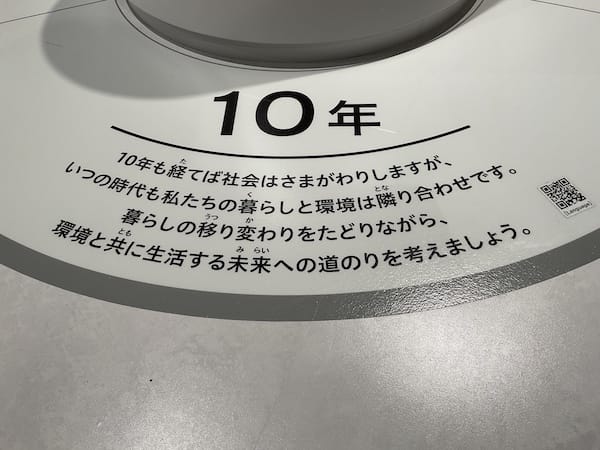
Society changes significantly after ten years, but our lives and the
environment are always intertwined.
Let's envision the path to a future where we coexist with the
environment while following our changing lives.

Period and environment race game
Eat, use, live
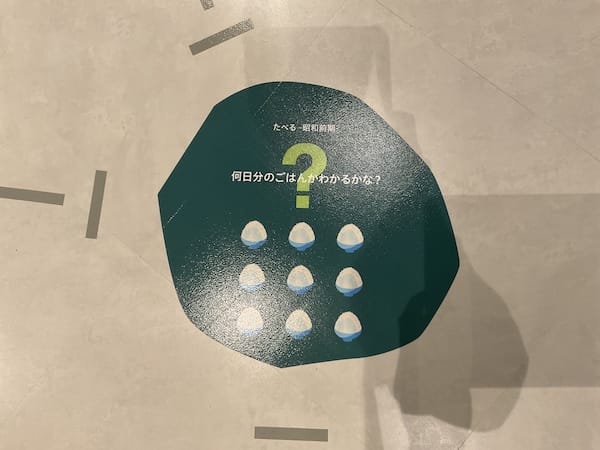
Q: Can you guess how many days worth of rice this is?

A. It's equivalent to one day's worth of rice in the early Showa
period!
People in this era ate only a few side dishes and a lot of rice
harvested in the area.

Do food choices change the environment?
Meals change with the times.
Food choices also impact the environment...

Hands-on activity
Choose ingredients according to your mission and place them on the
tray in the center.
Greenhouse gas emissions vary depending on the chosen
ingredients.
Can you guess which combination is the most environmentally
friendly?

Everchanging times
Japan's food today looks quite different compared to in the Showa
era
Since the 1960s, the Japanese diet has changed significantly. A much
higher consumption of livestock products (milk/dairy and meat) with
a much lower consumption of rice and vegetables particularly stands
out.
This is due to an increase in the number of staple foods made with
wheat such as bread and meat-dominant main dishes. In other words,
the diet has become globalized. As a result, the food
self-sufficiency rate has dropped significantly.

Wisdom for the future
A traditional Japanese diet: the key to healthy longevity
Recently, people have been rediscovering the traditional Japanese
diet. It is characterized by a well-balanced nutrition.
Rice is mostly eaten as a staple food with fish as the main dish. It
includes a variety of vegetables, mushrooms, seaweed, potatoes,
etc., using seasonal ingredients which leads to local production for
local consumption and increases the food self-sufficiency rate. It
also uses of soup stock, which reduces salt intake.
How about switching to the traditional Japanese diet which offers so
many benefits?

Q. Do you know the difference between an expiration date and a best-before date?
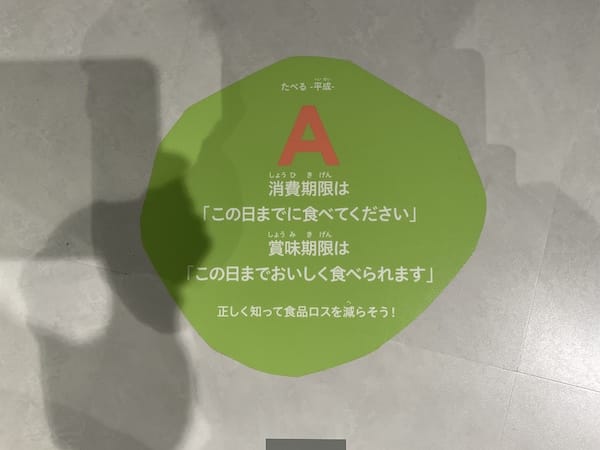
A. Expiration date is the date that the product should be eaten
by.
The best-before date is the date that it can be optimally enjoyed
by.
Be aware of the difference to reduce food loss!

Thinking about food loss together
A lot of food that can still be eaten gets thrown away

Hands-on activity
Open the bowls and the refrigerator.
You can see how much food loss we are responsible for.
Information is also hidden in the trash can on the wall. Open the
lid and try looking.
*Food loss refers to food that can still be eaten but gets thrown
away.

Food loss per person per day
About 124 g
About as much to fill a bowl
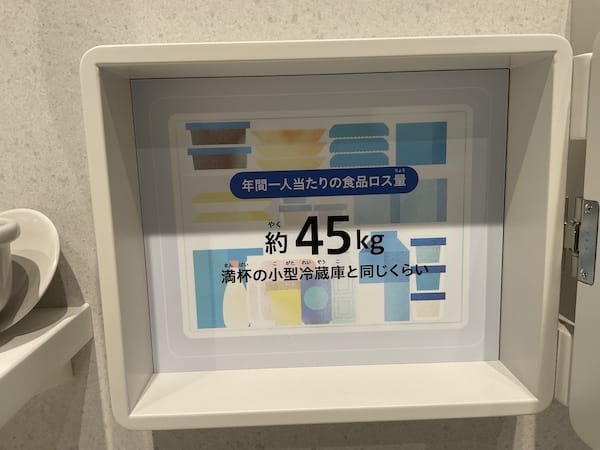
Food loss per person per year
About 45 kg
About as much food that fits in a small refrigerator
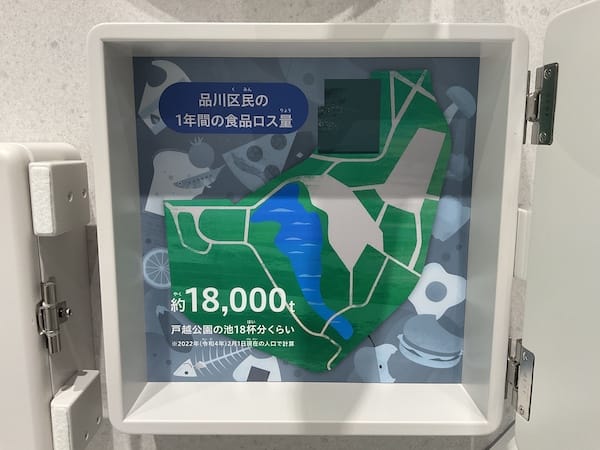
Amount of food loss in one year for Shinagawa residents
About 18,000 tons
Enough to fill the pond in Togoshi Park 18 times over
*Calculated based on the population as of February 1st, 2022

Everchanging times
Initiatives underway to prevent food loss
The government has set a goal to reduce the food loss of the
businesses that we are familiar with such as restaurants, grocery
stores, and food manufacturers, to half of the amount in 2000 by
2030. Further efforts are needed to achieve the goal.
What do you think we can do to reduce food loss?

Wisdom for the future
Support the shops working to reduce food loss!
Shinagawa City is promoting its "SHINAGAWA Mottainai Project".
Under the theme of reducing food loss, the project certifies
restaurants and retail stores in the city that mindfully handle food
as "mottainai supporters", working to expand the number of such
restaurants.
Look for this sticker around town.

When shopping, where do you put your bought items?
Considered "disposable" once used
That's not the only thing getting thrown away

Hands-on activity
Wrap two bottles in wrapping cloth.
Follow the steps and try the challenge!
*This method of tying is called "bottle wrapping" and it has been
passed down as a furoshiki (wrapping cloth) tradition since the Edo
period.

By bringing your own bag when shopping and declining to receive a
plastic shopping bag, you will have saved 6.8g of plastic (high
density polyethylene) for each L size bag.
6.8g of plastic = 8.2 ml crude oil equivalent
If you decline to use one plastic shopping bag every day for a year,
you can reduce the use of about 3 liters of crude oil per person,
equal to 365 bags.

Everchanging times
Bringing back reusable bags instead of throwing them away
Containers for shopping have changed with the times.
Plastic bags are convenient, but they are usually disposable. When
you finish using them, they become garbage.
Bringing your own bag can be a little troublesome, but it can be
used over and over again.
Which will you choose?
Recently, furoshiki (wrapping cloths) are being rediscovered for
their portability and ability to wrap anything.

Wisdom for the future
Plastic that can be decomposed by microorganisms
The drawback of plastic is that it remains in nature forever.
In contrast, biodegradable plastics that can be decomposed by
microorganisms are being developed.
Until now, most of them were decomposed by microorganisms in the
soil, but recently, marine biodegradable plastics have been put into
practical use and are beginning to be used for plastic shopping
bags, straws, containers, foam boxes, etc.

Q. What did people use to wrap things before there was plastic?
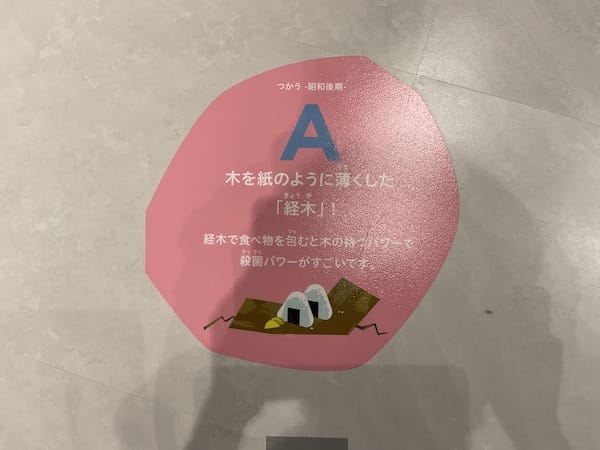
A. Paper-thin wood called "Kyogi"!
When wrapping food in kyogi, the power of the wood helps to keep it
sterile.
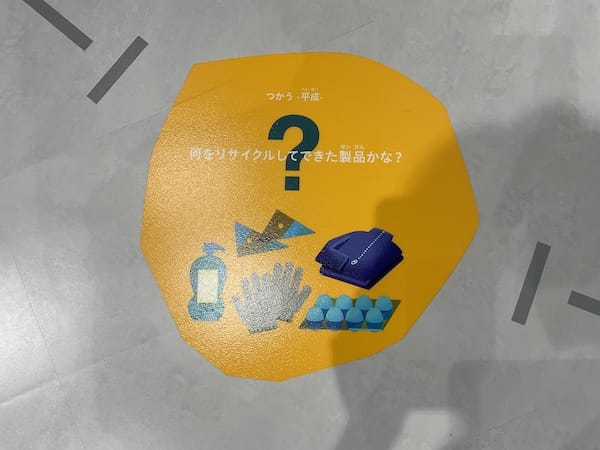
Q. What is this recycled product made out of?

A. Plastic bottles
85% of plastic bottles get recycled
They are reborn as various things such as containers, shirts and
stationery.

Where does plastic go?
The plastic we throw away improperly flows from rivers into the sea
and...

Hands-on activity
Open the stuffed animal,
and take a look inside.
What's in it?

Try imagining where plastic waste goes.
A plastic bag inside a turtle...
Pieces of plastic inside a seabird...
What about human bodies...?

Research has shown that humans also consume about one credit card's worth of plastic (up to about 5 g) per week.

Everchanging times
So many convenient and cheap plastic containers!
In the past, food containers were made from natural materials such
as wood and paper.
Eventually, plastic food containers became popular because of the
advantage of being able to mass-produce them cheaply.
Nowadays, refillable items like recycled products and plastic
containers have become the mainstream.

Wisdom for the future
Use containers that are environmentally friendly!
Eco-friendly containers such as 100% plant-derived plastic food
containers and containers made from recycled plastic bottles are
being developed.
In addition, more and more people are using their own refillable
bottles.
Shinagawa City also uses eco-friendly molded containers made from
sugar cane pomace at festivals and other events.
*Returnable containers: containers that are returned, collected,
washed, and used again by the manufacturer. Common examples include
beer bottles and Japanese liquor bottles, etc.

Q. What are these tools used for?

A. From the left, for washing, cooking and ironing!
Housework in the early Showa period was mostly manual work.
None of these use electricity.

Evolving lifestyles through the use of household appliances
Lifestyles with household electric appliances began with the use of
lamps and radios
We are surrounded by many household electric appliances today

Hands-on activity
Sort the pieces with various home appliances drawn on them by
era.
Try fitting the pieces into the missing parts of each era.
What is the difference in the number of home appliances that support
daily life in each era?

Everchanging times
The effects of energy saving and power saving also contribute to
household power consumption
With the rapid growth around the 1960s, the convenient household
appliances in our daily lives have become widespread, and household
power consumption has increased significantly.
Going forward, power consumption continued to increase with the
spread of digital communication devices such as PCs and smartphones,
but awareness of power saving increased in the wake of the nuclear
accident following the Great East Japan Earthquake (2011), and with
continued progress of energy-saving technology, power consumption is
currently on a downward trend.

Wisdom for the future
Enjoy an energy-saving lifestyle!
In Shinagawa City, shopping districts are coming together to promote
eco-friendly projects aimed at saving electricity such as "Mission
Uchimizu". Through these efforts, the city aims to promote and
enlighten lifestyles with less environmental impact and to save
energy at homes and in the community.
Uchimizu (sprinkling water on the ground to ease the heat)
originated from the wisdom of the Edo period, and it helps to lower
the temperature by causing water to evaporate. At an Uchimizu event
in Shinagawa City, sprinkling water on the ground lowered its
temperature by 3˚ to 4˚ Celsius.

How is energy made?
Sources of electricity
There are various methods of power generation
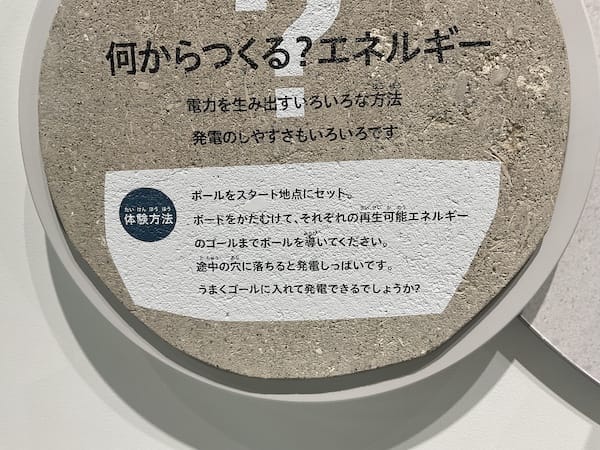
Hands-on activity
Set 10 balls on their starting point and begin the game.
Tilt the board and guide the balls into the holes representing
renewable energy.
The renewable energy holes are difficult!
How many can you get in?

Everchanging times
The combination of power generation methods that have changed over
time
For a while after the war, Japan's power was mainly generated by
hydropower, but afterwards, coal became the main source of energy,
followed by oil after the high growth period.
Then, from the end of the Showa era to the Heisei era, the ratio of
natural gas, coal, and nuclear power increased.
Renewable energy is increasing little by little, but it is still
around 10%.
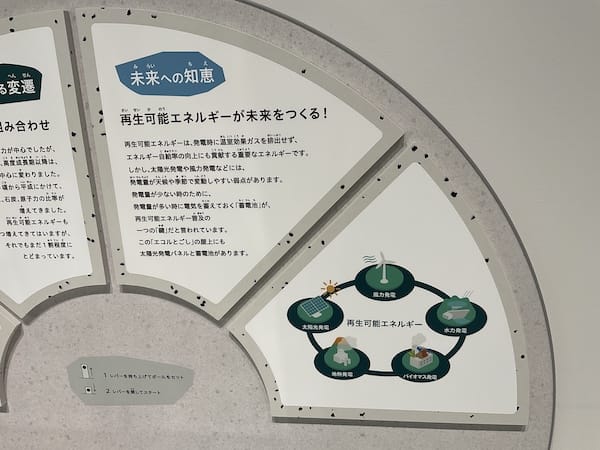
Wisdom for the future
Renewable energy will make our future!
Renewable energy is an important source of energy that does not emit
greenhouse gases during power generation and contributes to
improving the energy self-sufficiency rate.
However, a drawback of solar and wind power generation is that the
amount of power generation tends to fluctuate depending on the
weather and seasons.
Storage batteries that can store electricity when available in large
amounts for times when the supply is scarce are said to be one of
the keys to the diffusion of renewable energy.
There are also solar panels and storage batteries here on the roof
of Ecoru Togoshi.

Q. Where are Ecoru Togoshi's eco-friendly initiatives hidden?

A. Try to find them yourself.
There are hints in the exhibits all around the museum!

Will we be able to live closer to the environment ten years from now?